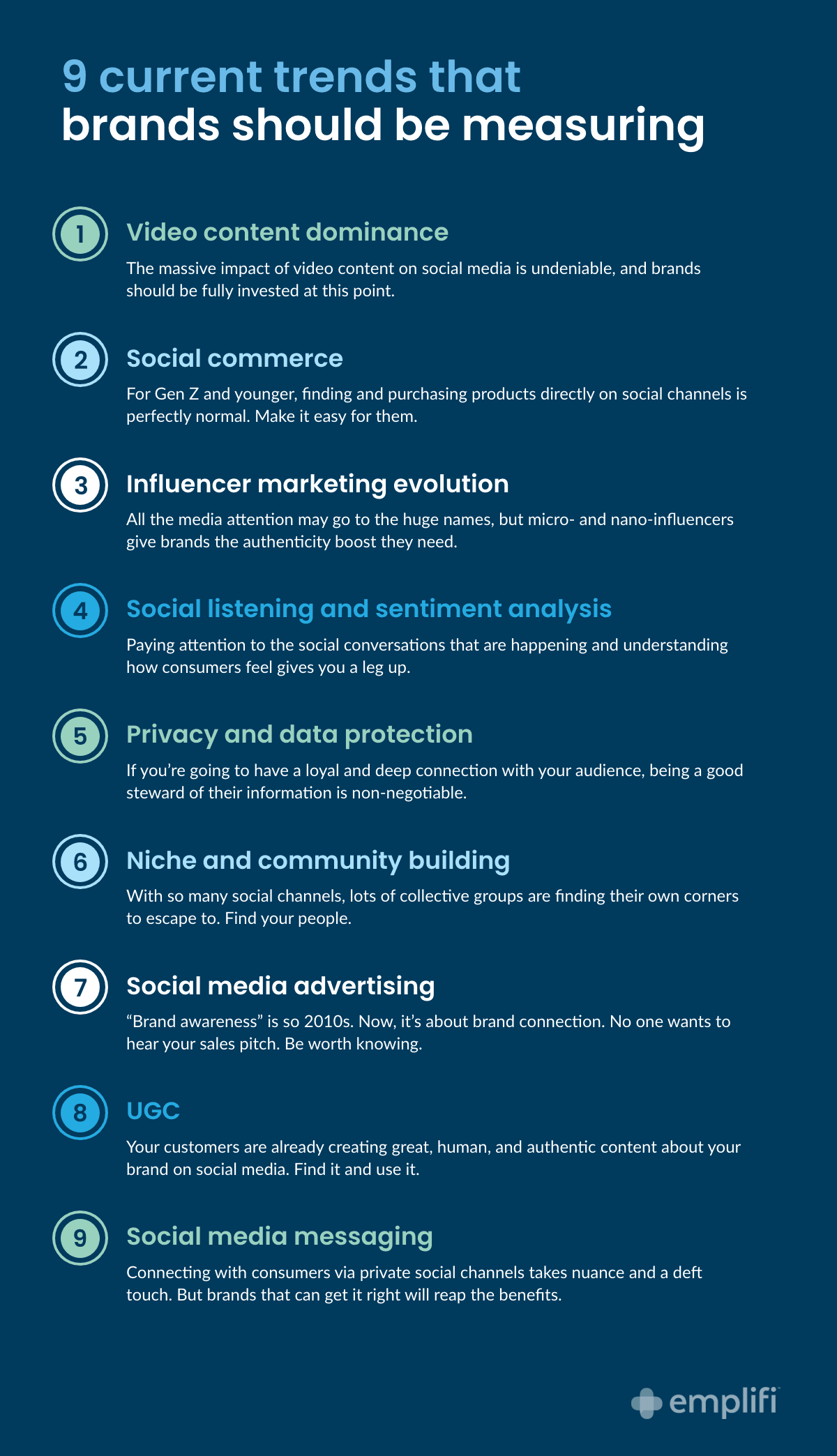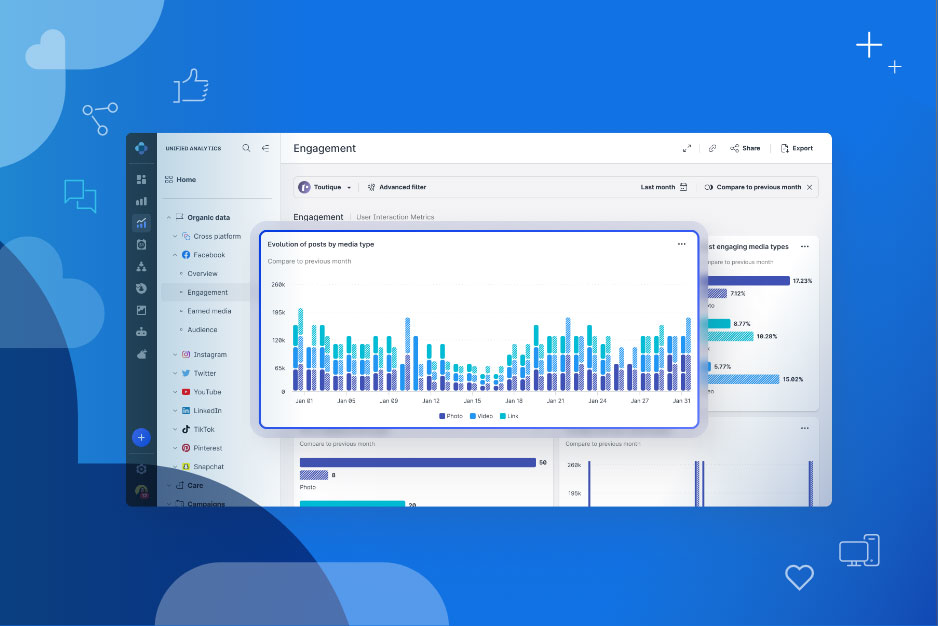For social media marketing teams looking to stay at the forefront of what’s happening in the social world, 2024 brings forth dynamic trends that demand attention. As the digital realm evolves, understanding and adapting to these trends is crucial for staying ahead in the competitive space.
Beyond identifying and keeping your work up-to-date on the latest trends, social marketers must know how to measure success in each of these areas. Whether it's the dominance of video content, the rising influence of micro- and nano-influencers, or the growing importance of social listening, each trend requires a unique approach to measurement for informed decision-making. Here’s a look at the biggest social trends right now, and how to measure them.

1. Video content dominance
Video content's reign continues unabated, with both short- and long-form videos, livestreaming, and interactive formats captivating audiences. This dominance isn't a new trend; it's a paradigm shift in how people consume content, and it’s imperative that marketing teams jump in with both feet.
To maintain relevance, marketers must not only produce visually compelling videos, but also stay agile, adapting strategies for emerging video trends on each platform. Whether it's TikTok's short bursts of creativity, Instagram Reels’ built-in discoverability, or YouTube's extensive content library, understanding and harnessing the power of each platform's unique video features is essential for a robust content strategy.
What to measure: Track metrics such as video views, completion rates, average watch time, and engagement (likes, comments, shares) for your video content. These metrics will help you assess the effectiveness of your social media video strategy and identify opportunities for improvement.
2. Social commerce
The marriage of social media and eCommerce continues to gain momentum. Social commerce, epitomized by shoppable posts and augmented reality shopping experiences, is transforming how users discover and purchase products. It's no longer sufficient for brands to have a static online presence; they must seamlessly integrate shopping experiences into their social media strategies.
From influencers showcasing products to in-app purchases, the entire customer journey is becoming more immersive and interconnected. Social marketers need to embrace these features and continually optimize strategies to drive sales and enhance the overall customer experience.
What to measure: Measure metrics related to social commerce, such as click-through rates (CTRs) on shoppable posts, conversion rates on in-app purchases, and revenue generated from social media-driven sales. These metrics will help you evaluate the impact of your social commerce efforts and optimize your strategy accordingly.
3. Influencer marketing evolution
The momentum in the influencer marketing world seems to be moving strongly toward micro- and nano-influencers. While mega-influencers may boast massive follower counts, the real power lies in the intimate connection these smaller influencers have with their engaged audiences, and the perception of authenticity that comes with it.
This shift demands a recalibration of influencer marketing strategies. Marketers must keep a vigilant eye on emerging influencers, recognizing that influence is no longer solely measured by reach, but by the depth of connection. Authentic collaborations with influencers who genuinely resonate with their audience can yield more significant results than high-profile partnerships.
What to measure: Monitor metrics such as engagement rates, reach, and conversions driven by influencer collaborations. Measure the performance of influencer-generated content and track the impact on brand awareness, engagement, and sales.
4. Social listening and sentiment analysis
The rise of social listening and sentiment analysis signifies a maturation in social media strategy. Beyond merely broadcasting messages, brands must now actively listen to the nuanced conversations happening online.
Social listening tools provide a real-time pulse on customer sentiment, enabling marketers to anticipate trends, manage reputations, and understand the intricacies of their audience. Sentiment analysis takes this a step further, helping brands gauge the emotional tone behind conversations. By employing these tools effectively, marketers gain invaluable insights into what resonates with their audience, leading to more nuanced and personalized communication strategies.
What to measure: Utilize sentiment analysis tools to measure sentiment scores, sentiment trends, and sentiment distribution related to your brand. Monitor changes in sentiment over time and identify any shifts that may require adjustments to your social media strategy or brand messaging.
5. Privacy and data protection
In an era dominated by data, privacy concerns, and regulations are reshaping the social media landscape. Users are more conscious than ever about how their data is handled, demanding transparency and control.
Social marketers must not only stay abreast of evolving privacy policies but also proactively integrate data protection measures into their strategies. This isn’t mere bare-bones compliance — it's about fostering trust. Brands that prioritize user privacy and communicate transparently about data handling build stronger, more enduring relationships with their audience.
In an age where data is a currency, respecting user boundaries is a cornerstone of ethical social media practices.
What to measure: Track metrics related to user consent, data handling transparency, and compliance with privacy regulations. Monitor opt-in rates for data collection, user preferences related to data usage, and any changes in user sentiment regarding privacy concerns.
6. Niche and community building
As they’re bombarded by more and more messages across legacy and emerging social channels, users find themselves seeking more personalized and authentic connections.
Niche communities are flourishing, providing users with spaces tailored to their specific interests. Social marketers must recognize the power of micro-communities within their broader audience and tailor content accordingly. It's not about reaching the masses but fostering deep connections with specific segments. Building engaged communities requires a shift from generic content to content that resonates profoundly with the values and interests of these niche groups.
Successful brands will understand that, in this era of personalization, one size does not fit all.
What to measure: Measure metrics such as community growth, engagement rates, and user-generated content (UGC) submissions. Monitor the growth and engagement of niche communities around your brand, and track the impact of community-building efforts on brand loyalty and advocacy.
7. Social media advertising
Advertising on social media is undergoing a transformative journey. It's no longer just about visibility but also about creating immersive, personalized experiences. Native advertising seamlessly blends with users' content streams, while interactive ad formats invite participation.
Social marketers must go beyond traditional metrics and focus on creating ads that capture attention and resonate with users on a personal level. Targeting options are becoming more sophisticated, allowing for hyper-personalized campaigns. Staying ahead means embracing these changes and constantly refining strategies to deliver advertising that feels less like an interruption and more like a welcomed part of the user experience.
What to measure: Track metrics such as click-through rates (CTRs), conversion rates, and return on ad spend (ROAS) for your social media advertising campaigns. Measure the effectiveness of your ad targeting, creative, and messaging to optimize your advertising strategy.
8. User-generated content
With each year that passes, UGC is becoming more of a cornerstone of authentic brand building. It's a testament to the community's involvement in shaping a brand's narrative that people continue to make such an impact entirely on their own via social media.
Encouraging users to create content strengthens brand authenticity and fosters a sense of belonging. Successful UGC campaigns go beyond showcasing products. They celebrate the creativity and individuality of the community. Social marketers should monitor the metrics while actively participating in the creation of UGC.
In doing so, they transform their audience from passive consumers to active contributors, creating a symbiotic relationship that goes beyond transactional engagements.
What to measure: Measure metrics related to UGC, such as the number of submissions, engagement rates, and reach of campaigns. Assess the impact of UGC on brand authenticity, engagement, and customer loyalty.
9. Social media messaging
The shift toward private and intimate communication channels represents a nuanced change in user behavior. Messaging apps and private groups provide a sanctuary from the noise of public feeds, fostering meaningful interactions.
Social marketers must recognize this shift and adapt their strategies to meet users where they are. From personalized messaging experiences to efficient customer service integration, engaging through messaging platforms requires a more human approach.
By understanding the nuances of these private channels, marketers can forge stronger connections, providing personalized support and fostering a sense of exclusivity that resonates with the desire for more intimate digital interactions.
What to measure: Monitor metrics such as response time, customer satisfaction ratings, and conversion rates for messaging app interactions. Measure the effectiveness of your messaging strategy in providing personalized and timely customer support and driving conversions.
Takeaways
To stand out to consumers and make an impact in 2024, social marketers must be nimble, adaptive, and data-driven. Embracing video content dominance, understanding the evolving influencer landscape, and mastering the art of social listening are no longer options but imperatives for success.
Whether it's navigating the intricacies of user privacy or building authentic connections within niche communities, the key lies in understanding the nuanced dynamics of each trend and tailoring strategies accordingly. The future of social media success belongs to those who not only identify the trends but also master the art of measurement, continuously optimizing strategies to meet the ever-evolving needs of their audience.
If you’d like to see how Emplifi Unified Analytics can give you the omnichannel visibility you need to understand exactly how social media is performing in one streamlined, easy-to-use UI, reach out and we’d love to show you.



































